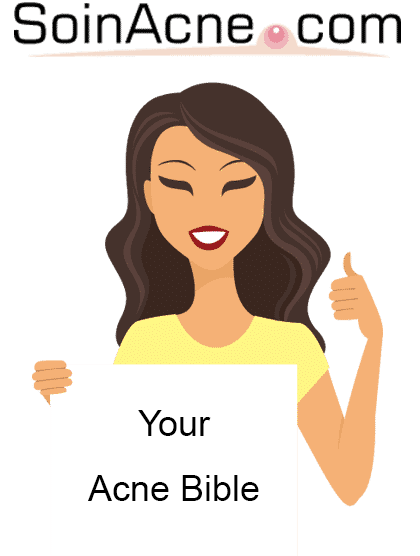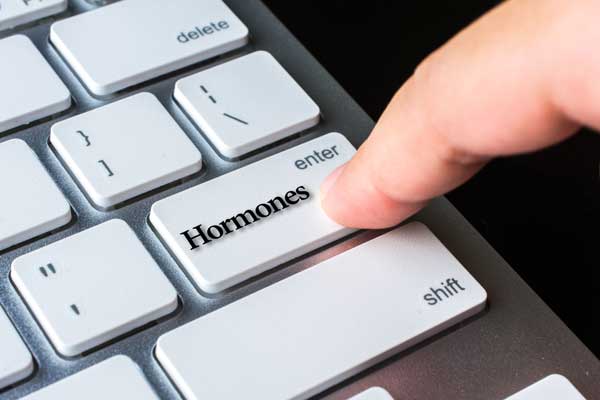Page Content
So many people suffer from it so frequently that this skin problem sometimes goes unnoticed. However, some types of acne can be very serious.
Regardless of the type of acne one faces, it often involves a hormonal mechanism.
This is because since acne is the result of follicular inflammation, it is under the control of the body’s hormones.
A simple fact that can support this theory is that acne usually starts to appear during adolescence.
As is well known, this is a time when a hormonal upheaval occurs within the body.
Hormones and seborrhea
As we just mentioned, acne is the result of inflammation of the pilosebaceous follicle.
The latter is a structure consisting of sebaceous glands associated with hairs. Sebaceous glands are responsible for the secretion of sebum: an oily fluid that normally has a protective role for the body.
When this fluid is normally secreted, the sebum continuously flows through the follicular ostium – the place where the hair emerges from the epidermis – to cover the skin’s surface. It protects the skin from external aggression from microorganisms and keeps it from drying out.
However, sometimes the secretion of sebum is exaggerated: this is known as hyperseborrhea.
This increase is caused by an increase in certain sex hormones, which also creates an accelerated production of keratinocytes.
In this case, an obstruction of the pilar canal occurs. This duct is the conduit through which sebum flows along the base of the hair, before exiting through the follicular ostium.
The obstruction is therefore caused by an excess of sebum, or by sebum that is too viscous. Dead skin cells can also block the hair shaft. Thus, the migration of sebum is no longer possible.
In addition, excess sebum promotes the proliferation of Propionibacterium acnes, a bacterium responsible for the inflammation of pilosebaceous follicles and the formation of pustular lesions such as papules, pustules and nodules, hence the appearance of acne.
Acne is therefore hormonally controlled.
Hormonal regulation of sebaceous excretion
Some physiological activities of the body are under the control of hormones, while others are controlled by the nervous system.
When we examine the structure of pilosebaceous follicles or, more specifically, that of the sebaceous gland, we notice that the nerve fibers surrounding this gland are very sparse.
It is thus quite simple to deduce that sebaceous secretion is not under the control of the nervous system. On the other hand, the sebaceous gland is abundantly vascularized. It is therefore stimulated by hormones – especially sexual hormones – which are released into the bloodstream.
This hormonal control of sebaceous secretion – which also regulates the multiplication of sebocytes – is evident and is easily seen through the quantitative variations in sebaceous excretion occurring with age, pregnancy, sex…
Variations with age
A significant secretion of sebum occurs at birth. This can last for about a month before it starts to gradually decrease, reaching its minimum level at about six months of age.
As one might expect, these variations in infants are not entirely explained by variations in circulating androgen levels.
In fact, until the child reaches the age of 7 years, sebum secretion remains low. It then increases, first under the influence of adrenal androgens, then under that of gonadal androgens (until the age of 12 to 15 years). This sebaceous secretion finally remains stable before beginning a decline during aging.
As an adult, sebaceous secretion is generally higher in men than in women. The main stimulus for this secretion is androgens.
These are, for the most part, secreted by the gonads and adrenal glands. However, they can also be produced locally, within the sebaceous gland, from dehydroepiandrosterone sulfate.
The major androgen in men is testosterone, which is secreted in the testes. In women, delta-4-androstenedione formed by the ovaries appears to be the main trigger for sebaceous gland activity, along with dehydroepiandrosterone and its sulfate, which are of adrenal origin, and in particular, precursors to testosterone.
Regulatory process
Regulation of sebaceous excretion involves androgen alpha-reduction, combined with the action of other hormones.
Alpha-reduction of androgens
In the blood, testosterone will bind to SHBG – Sex Hormon Binding Globulin – and albumin. At the level of the sebaceous gland, the free fraction of testosterone and its precursors will be transformed into dihydrotestosterone (DHT). This is the only substance capable of stimulating sebum secretion.
At the level of the sebaceous gland, other enzymes can also be distinguished and play a minimal role. This is the case with 3-bệta-hydroxysteroїdehydrogenase, which converts delta-4-androstenedione into testosterone.
When DHT is formed, it binds to a specific cytosolic receptor in order to return to the nucleus of the sebocyte, where it will bind to a specific receptor in the nucleus in order to stimulate the genes involved in sebum secretion.
In the case where circulating androgens in the acne sufferer are at a normal level, it is probably that :
- There is an increase in the number of dihydrotestosterone receptors as well as the subject’s sensitivity to this hormone – acne is thus considered a “peripheral hormonal disease“
- there is an elevated number of certain receptors that increase the metabolism or production of DHT, such as neuromediator receptors.
These receptors are activated by substance P, and by alpha MSH – Melano Stimulating Hormone – which peripheral nerve fibers release, especially during stress. In acne-prone subjects, peripheral nerve fibers are more numerous at the sebaceous glands. A link between acne flare-ups and stress is beginning to emerge.
Other hormones
Apart from androgen alpha-reduction (which is the key determinant of sebocyte hormone dependence), there are also other hormones that play a direct and indirect role on sebaceous function.
For example, endogenous and synthetic progestins also have an ability to bind to androgen receptors. This relative affinity of androgens and progesterone to receptors allows the ranking of these hormones according to their potential antiseborrheic effect.
In addition, estrogens increase the level of SHBG – a protein that transports testosterone and estrogen – in plasma. This results in a decrease in the free fraction of usable testosterone. The estrogens will then act within the sebocytes.
By an indirect mechanism of reduction of the SHBG level in the plasma, there is an increase in seborrhea by the excess glucocorticoids. Corticosteroids disrupt ovulation in women, creating functional ovarian hyperandrogenism.
Also, growth hormone has a regulatory role in the sebum secretion process. This regulation is done directly or indirectly, via a local and hepatic secretion of IGF-1 (insulin-like growth factor-1).
Hormonal acne treatment
There are traditional drug treatments that can be very effective for hormonal acne. It is also possible to opt for hormone therapy.
Medicated treatments
Here we can distinguish between topical and oral treatments.
Local-use treatments (topical)
These treatments exist in the form of gels, creams, lotions or ointments. Among them, we distinguish:
- The azelaic acid: It can be found in gel form (Finacea®).
- The retinoids (Retin-A®, Effederm®, Roaccutane®, Curacné®, Differine® …): These molecules unclog the skin by acting on comedones. They have an anti-inflammatory effect and fight against Propionibacterium acnes.
- The benzoyl peroxide (Cutacnyl®, Brevoxyl®): It helps fight Propionibacterium acnes and also has keratolytic activity. It is particularly indicated against inflammatory lesions.
- The topical antibiotics (erythromycin, clindamycin): As their names suggest, these are antibacterial. They can be combined with azelaic acid or retinoids. They are effective against inflammation.
Oral treatments
These treatments are used against extensive, moderate or severe forms of acne; when these forms are resistant to topical treatment. Here, we can distinguish:
- The zinc (zinc gluconate): It can be combined with topical treatments. It is indicated as a cure for inflammatory acne.
- The antibiotics of the tetracycline family (doxycycline): They can also be combined with topical treatments. They help reduce papules and pustules.
- The isotretinoin (Curacne®Gé, Isotretinoin TEVA…): It is a vitamin A derivative that can be used when other treatments fail. However, it should be noted that isotretinoin is contraindicated for women in pregnancy, as it is susceptible to teratogenic effects. Before any use, it is therefore indispensable to do a pregnancy test and that this test does reveal that the woman is not pregnant. The treatment must necessarily be associated with a contraceptive method and the pregnancy test must be regularly redone.
Hormonal treatments
As noted, hormonal acne is primarily under the influence of androgens. Thus, one can logically use an anti-androgen treatment to combat this dermatosis.
These treatments help slow down the excessive sebum secretion caused by androgens. There are many such medications on the pharmaceutical market. These drugs act by regulating the excessive quantities of androgens responsible for acne.
A distinction can be made between estrogen-progestin and cyproterone.
Oestroprogestins
These are birth control pills for women. As the name may indicate, they contain an estrogen and a progestin.
An acne-prone woman on hormonal birth control should make sure that her birth control does not contain androgenic progestins (levonorgestrel, norethisterone…).
Indeed, these aggravate acne. Instead, choose contraceptives containing a weakly androgenic or anti-androgenic progestin. Estrogen-progestogens are used in addition to conventional treatments.
However, it is important to note that there are risks of thromboembolic events with hormone use. For this reason, anti-androgen pills are not prescribed as a first-line treatment. It is therefore essential to refer to a doctor.
Cyproterone
It is found in anti-acne medications such as Diane-35®, Andocure®, etc.
These hormonal methods are effective against moderate acne and also against severe acne, if previous treatments fail.
Final Advice
Finally, let’s note that it’s important to avoid certain behaviors if you want to fight hormonal acne the easy way.
To name a few, you should avoid too much exposure to the sun, triturating your pimples, using comedogenic cosmetic products, drinking alcohol, being stressed…, in short, avoid anything that could aggravate your acne condition.
It is important to have a good lifestyle. A gentle cleansing in the morning and evening helps rid the body of excess sebum and other impurities.
However, when showering, avoid alcoholic lotions and Marseille soaps. These products dry out the skin and can cause seborrhea.
Instead, opt for adapted soap-free, antibacterial, mild or slightly detergent, slightly acidic bars.

